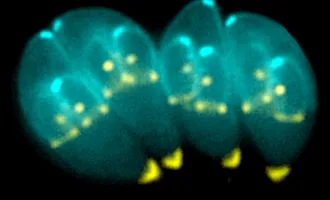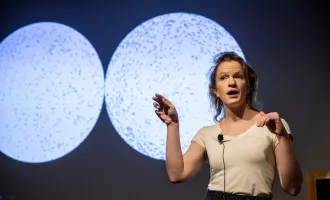Journal Club: Stem Cell Biology, Immunology, and Physiology
STEM CELL BIOLOGY: MicroRNA-based discovery of barriers to dedifferentiation of fibroblasts to pluripotent stem cells. Judson, R.L.; Greve, T.S.; Parchem, R.J.; Blelloch, R. Nature Structural and Molecular Biology. September 15. [Epub ahead of print]
MicroRNAs are known for regulating families of related genes by targeting the genes for degradation. Because of this propensity to alter the regulation of whole gene families, instead of individual genes, miRNAs are often eyed as the drivers of cellular events that require a large change in gene transcription, such as cell differentiation. In this paper, researchers screened fibroblast cells going through de-differentiation into induced pluripotent cells (iPSCs) to look for changes in different miRNAs, and found that the mir-181 family was a novel enhancer of iPSC reprogramming.
During normal iPSC reprogramming, the mir-181 family is upregulated and when the mir-181 family was inhibited, they saw fewer clusters of iPSCs in cell culture. Along with the mir-302/294 family (which has previously been identified as a driver of de-differentiation), the mir-181 family works together to inhibit a set of 25 genes that normally prevent de-differentiation into iPSCs.
IMMUNOLOGY: Type 2 innate lymphoid cells control eosinophil homeostasis. Nussbaum, J.C. et al. (Locksley). Nature. September 15. [Epub ahead of print]
Eosinophils are a cell type that help protect us against parasite infection; unfortunately, they also often contribute to inflammatory diseases such as asthma. One surprising and odd discovery about eosinophils made long ago was that they seemed to exhibit some type of circadian rhythm: one study found that individuals with high eosinophil numbers tended to have the most in the evening and significantly fewer during the day, though the cause of this cycle was never identified. Circadian rhythm can also influence other cell types, too. In this paper, researchers linked circadian rhythm to eosinophil prevalence and activity through type 2 innate lymphoid cells (or “ILC2” cells), an extremely rare cell type that reside in peripheral tissues and are thought to contribute to Th2 (or “allergic”) disease. Normally, ILC2 cells secrete basal levels of IL-5 to promote a baseline level of eosinophil infiltration of the body. During inflammation, they will also secrete IL-13 and promote eosinophilic inflammation. Here, they found that circulating circadian rhythm factors interact with ILC2 cells and cause them to secrete larger amounts of IL-5, a cytokine that promotes eosinophil generation and homeostasis. This way, ILC2s promote the circadian cycling of eosinophil levels through IL-5.
PHYSIOLOGY: Insulin-like growth factor-1 receptor in mature osteoblasts is required for periosteal bone formation induced by reloading. Kubota, T. et al. (Bikle). Acta Astronautica. 92(1):73-78.
Physical stress is one thing required to keep our bones strong. Constant loading and unloading of weight onto our bones helps to ‘remind them’ to maintain their strength and prevents breakdown of the minerals in our bones in favor of other organs that could use those minerals otherwise. This phenomenon is why astronauts must keep to such stringent exercise regimens: if they didn’t, their bones would become profoundly weak and could even break upon normal activity back on earth. Insulin-like growth factor-1 (IGF-1) is a hormone involved in the homeostasis of bone formation and catabolism, and in this paper, researchers wanted to determine if its function was linked to bone stress. To test this, they unloaded bone stress from either wild-type or IGF-1 receptor knockout mice and looked at the rate of bone strengthening upon bone reloading. IGF-1 receptor knockout mice had loss of periosteal bone reformation but normal endosteal bone reformation, indicating that the hormone’s role in bone homeostasis is at least in part linked to bone stress.
IMMUNOLOGY: Circadian gene Bmal1 regulates diurnal oscillations of Ly6Chi inflammatory monocytes. Nguyen, K.D. et al. (Chawla). Science. 341(6153):1483-8.
As mentioned above, some innate immune cells, such as ILC2 cells and eosinophils exhibit circadian regulation, which can contribute to different strengths of immune processes at different times of day. Researchers have been interested in how many other immune cells respond to circadian rhythm as well, and monocytes (a very ubiquitous but still quite mysterious cell type) are one example. Here, researchers found a change in inflammatory blood monocyte numbers depending on the time of day, which even translated to a susceptibility to Listeria bacterial infection depending on the time of day that the bacteria were introduced. This regulation was shown to be dependent on the circadian regulator BmaI1. When BmaI1 was deleted, the mice became susceptible to a number of inflammatory conditions, indicating that circadian regulation helps to carefully control the potential for immune-mediated inflammation.


